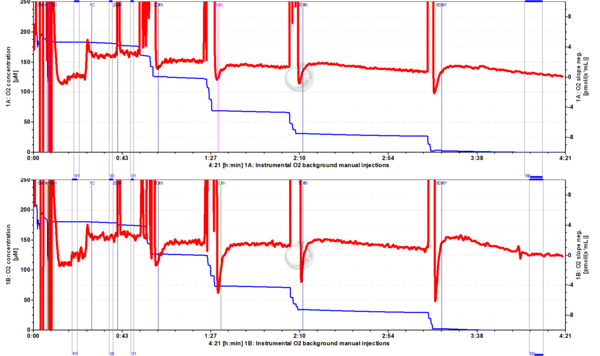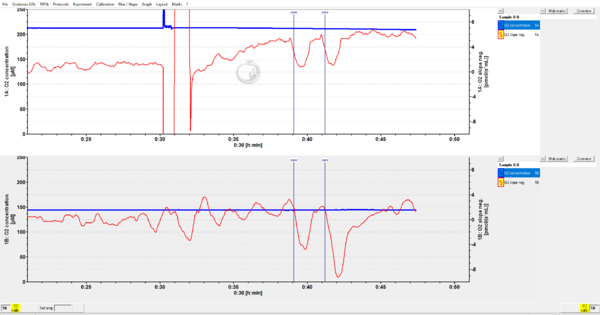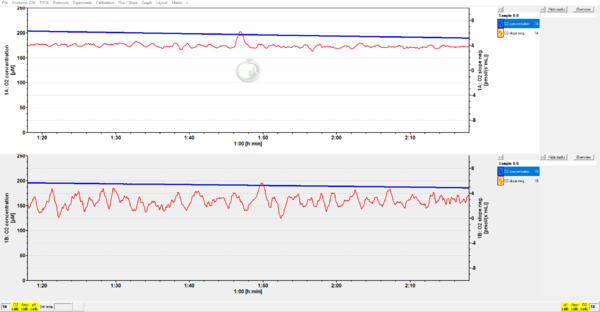Description
Zero oxygen solution powder, Na2S2O4, used for calibration of oxygen sensors at zero oxygen, or for stepwise reduction of oxygen concentration in instrumental O2 background tests.
Abbreviation: Dit
Reference: MiPNet06.03 POS-calibration-SOP, MiPNet14.06 Instrumental O2 background
MitoPedia O2k and high-resolution respirometry:
O2k-Open Support
Preparation
- Preparation of 30 mM dithionite solution for instrumental oxygen background (dissolved in Phosphate buffer, 50 mM, pH 8)
- Weigh 0.051 g dithionite, sodium hydrosulfite, and transfer to 10 mL volumetric glass flask.
- Adjust final volume to 10 mL with Phosphate buffer and keep closed to avoid decomposing.
- Preparation of 10 mM dithionite solution for instrumental oxygen background (dissolved in Phosphate buffer, 50 mM, pH 8)
- Weigh 0.017 g dithionite, sodium hydrosulfite, and transfer to 10 mL volumetric glass flask.
- Adjust final volume to 10 mL with Phosphate buffer and keep closed to avoid decomposing.
- Note: Experiments performed with 10 and 30 mM dithionite solution showed identical results. However, sodium dithionite is slowly oxidized by air. When dithionite is open for long time, we recommend to use a concentration of 30 mM for performing the instrumental oxygen background. For new dithionite, 10 mM dithionite solution may be used.
- From MiPNet06.03 POS-calibration-SOP (Version 14): Prepare "zero solution" by dissolving c. 20 mg sodium hydrosulfite (OroboPOS-Service Kit) or two tips of a spatula in 0.5 ml of water. Mix in a small vial with minimum gas space. Use fresh. Dithionite may not work after prolonged storage.
Further information »Talk:Dithionite
O2k open support cases
- Customer ID: CH Lausanne Kayser B
Question:
I ran a zero oxygen calibration after the instrumental background protocol and the O2 neg slope for O2 concentrations of 60 and 30 uM is positive and greater compared with the O2 neg slope at O2 concentrations of 180 and 120 uM. The data is attached (2019-09-11).
Answer: Stepwise analysis of the attached data shows the following:
Quality control (QC) 1: Your POS operates perfectly: during air calibration the O2 slope neg. approaches zero (see section 2.1 of https://wiki.oroboros.at/images/7/77/MiPNet06.03_POS-Calibration-SOP.pdf);
Quality control (QC) 2: In the closed chamber, the O2 slope neg. is <4 pmol s-1 mL-1 which excludes any biological or chemical contamination from the MiR05 buffer. https://wiki.oroboros.at/images/6/65/MiPNet14.06_InstrumentalO2Background.pdf;
- From your dithionite titrations we can observed that:
- After titrations of 2.5 µL of Dith, the step representative of O2 consumption is too small – indicative of a low effective potency of the solution of Dith;
- At increasing concentrations of Dith towards stepwise lower O2 concentrations, we observe that the O2 slope negative does not decrease in a titration dependent manner. Therefore, O2 is being consumed by the solution even after the initial fast decline of oxygen. Since we excluded other potential problems, the irregular background traces are due to the Dith solution.(see representative trace on page 5 of https://wiki.oroboros.at/images/6/65/MiPNet14.06_InstrumentalO2Background.pdf)
Taken together, your dithionite is highly oxidised and a continuing oxidation reaction explains the results.
Solution: Assuming you prepared the Dith according to our SOP (always fresh, http://bioblast.at/index.php/Dithionite), I advise you to purchase a new Dith powder (your Dith may be old and/or has oxidized).
Anonymous user
Question:
Q1: The Oxygen Concentration couldn't go down while I tried zero oxygen calibration. No matter how much solution I added, the oxygen concentration still remain the same. I reassembled, but it still keeps the same. The data is attached.
Q2: The chamber B's oxygen slope is not stable. This is a new problem I have never seen. Please see the attachment.(2019-04-26)
Q3. The maximum Oxygen concentration of another Oroboros O2k is only about 140 μM. I don't how to increase the starting point of oxygen concentration.
Answer:
A1: I suspect that the dithionite solution was not correctly prepared or not fresh. Dithionite loses activity quite fast, so you need to make it freshly. Please check this site: http://bioblast.at/index.php/Dithionite
A2: While there is a difference between chambers A and B, the stability of the signal is still within the acceptable range of noise given by the specifications of the instrument, see: Oxygen_sensor_test.
A3: You may simply need to calibrate, please see here: http://wiki.oroboros.at/index.php/O2_calibration_-_DatLab
MitoPedia methods:
Respirometry




